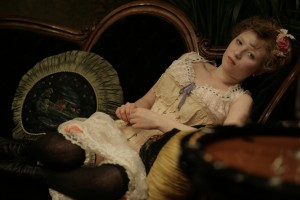‘House of Pleasures’ finds sadness in a turn-of-the-century Parisian brothel

Director Bertrand Bonello’s Cannes Film Festival hit, House of Pleasures, painstakingly details the sad liaisons of a Paris brothel, circa 1900. The Belle Epoque period is gearing up in the streets, but the women who work for Madam Marie-France (Noemie Lvovsky) are unable to fully experience the splendors of the city. Instead, they are relegated to a shut-in life, one of fake luxury and constant flirtations throughout the evening hours.
Bonello’s film is exquisitely produced and shot, featuring a rich detail to the time period and lavishly designed costumes. The women and their clients lounge around living rooms, sporting long-stemmed cigarettes, dapper suits and frilly dresses. They drink Champagne and eventually head up to secretive rooms. A panther on a leash sleeps on the couch, completing the picture of frivolity and decadence.
L’Apollinde, the name of the brothel, gives the impression of glamor, but beneath the veneer is a deep sadness. The women who populate the house — played by Hafsia Herzi, Céline Sallette, Jasmine Trinca, Adele Haenel, Alice Barnole and Iliana Zabeth — play their part, but they have largely given up on life. Their prospects of one day finding a husband, having children or even living beyond the age of 30 seem like fantasies. Marie-France requires a strict attention to the rules of the house, and this means cleanliness, bedtimes and few trips into the city. They are forever tied to L’Apollinde, even though the house is facing financial pressure to close its doors.
The recently released DVD from IFC Midnight and MPI Media Group captures Bonello’s film, highlighting the soft lights and ensemble acting. There’s a touch of Robert Altman in how the director moves throughout the house, from one room to another, always peeking in, but never staying for too long.
Although the story is told in a linear fashion, the director repeats some of the scenes and utilizes flashbacks to show how some nights at the brothel can turn monotonous, while others can turn violent. The scars of this profession can be found on each of the women, and the wounds cut right to the heart. They are imprisoned in their predicament, unable to leave because of financial concerns.
The movie trips up on a few fronts. There are obvious parallels to the timelessness of prostitution, and Bonello tries too hard to connect 1900s Paris with the present day. While lounging in the living room, we hear the Moody Blues’ Nights in White Satin blasting on the soundtrack. The musical interludes are jarring and seem to cheapen what is essentially a period film.
There’s also the lack of a main character. The screenplay chooses to focus on all the women, and this creates a nice ensemble feel, but the plot also comes off rather unfocused. We get to know a little about each of the characters, never following one from beginning to end. The distance that this storytelling technique creates can prove frustrating.
House of Pleasures (also known as L’Apollinde – Souvenirs de la Maison Close) is an uncomfortable look at the birth of sadness. These women, evidenced by their blank stares, deserved more from life.
By John Soltes / Publisher / John@HollywoodSoapbox.com
-
House of Pleasures
-
In French with English subtitles
-
2012
-
Written and directed by Bertrand Bonello
-
Starring Noemie Lvovsky, Hafsia Herzi, Céline Sallette and Jasmine Trinca
-
Running time: 125 minutes
-
Not Rated
-
Rating:





